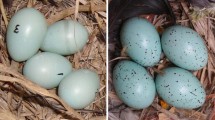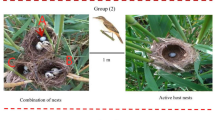Abstract
Hypotheses regarding the evolution and maintenance of intraspecific nest parasitism were tested with data collected during a 3-year study of common eiders (Somateria mollissima) breeding near Churchill, Manitoba. The nest parasitism rate was highest (42.4% of nests) during the year with the highest nest density and the best environmental conditions, and lowest (20.2% of nests) in the year with the lowest nest density and the poorest environmental conditions. Over the nesting season, parasitic eggs were laid at the same time as normally laid eggs. Most parasitic eggs (>75%) were laid before the host female laid her third egg. The majority of the parasitic eggs were the first or second egg produced by the parasitic female. When a parasitic egg was laid before or on the same day as the host female initiated her clutch, the probability of her first egg being depredated before incubation was significantly lowered. First- and second-laid eggs suffered a high rate of predation probably because nesting females do not attend their clutch until their second or third egg is laid. Hypotheses that some females use intraspecific nest parasitism to parasitize the parental care of other females were inconsistent with these data. Egg adoption is a likely explanation for the prevalence of females incubating parasitic eggs in this population.
Similar content being viewed by others
Author information
Authors and Affiliations
Additional information
Received: 30 September 1997 / Accepted after revision: 6 May 1998
Rights and permissions
About this article
Cite this article
Robertson, G. Egg adoption can explain joint egg-laying in common eiders. Behav Ecol Sociobiol 43, 289–296 (1998). https://doi.org/10.1007/s002650050493
Issue Date:
DOI: https://doi.org/10.1007/s002650050493




